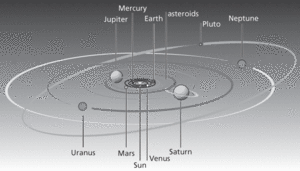The collective name for the Sun and all the material that orbits it. It includes the eight major planets, at least five dwarf planets, and over 170 known satellites, plus countless asteroids, comets, and meteoroids. There is no single measure that defines the boundary of the Solar System. Many Kuiper Belt objects lie beyond the orbits of the outer planets, the Sun’s heliopause is even more distant (around 120 au out), and the gravitational influence of the Sun extends halfway to the nearest star. The Solar System has an age of 4.57 × 109 years.
The Sun (a star) and all the bodies orbiting it: the eight planets (Mercury, Venus, Earth, Mars, Jupiter, Saturn, Uranus, and Neptune) dwarf planets (including Ceres and Pluto), their moons, and smaller objects such as asteroids and comets. The Sun contains 99.86% of the mass of the Solar System. The planets orbit the Sun in elliptical paths, and in the same direction as the Sun itself rotates. The planets nearer the Sun have shorter orbital times than those further away since the distance they travel in each orbit is less.
The inner planets (Mercury, Venus, Earth, and Mars) have solid, rocky surfaces; relatively slow periods of rotation (Mercury takes 59 days to complete one rotation, Venus 243 days, Earth nearly 24 hours, and Mars 24.5 hours); very few natural satellites; and diameters less than 13 000 km. Venus can be seen with the unaided eye, appearing in the evening as the brightest ‘star’ in the sky. In contrast, the outer planets (Jupiter, Saturn, Uranus, and Neptune) have denser, gaseous atmospheres composed mainly of hydrogen and helium; fast periods of rotation (Jupiter takes under 10 hours for one rotation, Saturn nearly 10.25 hours); and many natural satellites. Uranus, Neptune, and dwarf planets Ceres and Pluto were discovered after the development of the telescope.
The Solar System gives every indication of being a strongly unified system having a common origin and development. It is isolated in space. All the planets go around the Sun in orbits that are nearly circular and coplanar, and in the same direction as the Sun itself rotates. Moreover this same pattern is continued in the regular system of satellites that accompany Jupiter, Saturn, and Uranus. It is thought to have formed by condensation from a cloud of gas and dust in space about 4.6 billion years ago.

Most of the objects in the Solar System lie close to the plane of the ecliptic. The planets are tiny compared to the Sun (not shown to scale). If the Sun were the size of a basketball, the planet closest to the Sun, Mercury, would be the size of a mustard seed 15 m from the Sun. The most distant planet, Pluto, would be a pinhead 1.6 km away from the Sun. The Earth, which is the third planet out from the Sun, would be the size of a pea 32 m from the Sun.
Credit: Research Machines plc
https://solarsystem.nasa.gov/solar-system/our-solar-system/overview/ Summary of the Solar System, with descriptions of each of the planets, dwarf planets, and major moons.
http://www.lpi.usra.edu/research/outerp/moons.html Detailed and highly comprehensive page about the satellites of the outer planets. With links to separate pages for every satellite covered, this is more of a resource to dip into than read from start to finish. Images of each satellite are also provided, plus links to a special three-dimensional tour of the Solar System.
http://www.solarviews.com/eng/homepage.htm Educational tour of the Solar System. It contains information and statistics about the planets, moons, asteroids, comets, and meteorites found within the Solar System and is supported by images.
- exclusive union
- ex contradictione quodlibet
- excretion
- ex dividend
- exe
- executable content
- executables
- executable virus
- execute
- execute phase
- execute step
- execution states
- execution time
- executive information system
- executive program
- executive state
- exeligmos
- exercise
- exercise price
- exerciser
- exergonic
- exergonic reaction
- exergy
- ex falso quodlibet
- exfoliation